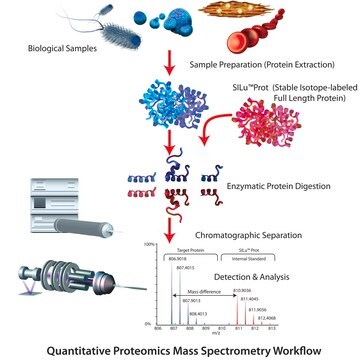일반 설명
We are committed to bringing you greener alternative products, which adhere to one or more of The 12 Principles of Green Chemistry.This antibody is Preservative-free, produced without the harm or sacrifice of animals and exceptionally stable to allow for ambient shipping and storage if needed and thus aligns with "Waste Prevention", "Designing Safer Chemicals" and "Design for Energy Efficiency".
Click here for more information.
ZooMAb® antibodies represent an entirely new generation of recombinant monoclonal antibodies.Each ZooMAb® antibody is manufactured using our proprietary recombinant expression system, purified to homogeneity, and precisely dispensed to produce robust and highly reproducible lot-to-lot consistency. Only top-performing clones are released for use by researchers. Each antibody is validated for high specificity and affinity across multiple applications, including its most commonly used application. ZooMAb® antibodies are reliably available and ready to ship when you need them.
특이성
Clone 1H21 is a ZooMAb® rabbit recombinant monoclonal antibody that specifically detects Neuropilin-1. It targets an epitope within 19 amino acids from the C-terminal region.
면역원
KLH-conjugated linear peptide corresponding to 19 amino acids from the C-terminal region of human Neuropilin-1.
애플리케이션
Quality Control Testing
Evaluated by Western Blotting in Human umbilical vascular endothelial cells (HUVEC) lysate.
Western Blotting Analysis: A 1:10,000 dilution of this antibody detected Neuropilin-1 in Human umbilical vascular endothelial cells (HUVEC) lysate.
Tested applications
Flow Cytometry Analysis: 0.1 μg from a representative lot detected Neuropilin-1 in one million Human umbilical vascular endothelial cells (HUVEC).
Affinity Binding Assay: A representative lot of this antibody bound Neuropilin-1 peptide with a KD of 2.2 x 10-8 in an affinity binding assay.
Immunocytochemistry Analysis: A 1:100 dilution from a representative lot detected Neuropilin-1 in Human umbilical vascular endothelial cells (HUVEC).
Note: Actual optimal working dilutions must be determined by end user as specimens, and experimental conditions may vary with the end user
표적 설명
Neuropilin-1 (UniProt: O14786; also known as Vascular endothelial cell growth factor 165 receptor, CD304) is encoded by the NRP1 (also known as NRP, VEGF165R) gene (Gene ID: 8829) in human. Neuropilins are highly conserved, non-tyrosine kinase, single-transmembrane glycoproteins that serve as co-receptors for various molecules, including semaphorins and vascular endothelial growth factors (VEGF). Neuropilin-1 is a single-pass type I, homodimeric, membrane glycoprotein that is synthesized with a signal peptide (aa 1-21), which is subsequently cleaved off to generate the mature form that contains a long extracellular domain (aa 22-856), a transmembrane domain (aa 857-879), and a cytoplasmic domain (aa 880-923). It acts as a receptor involved in the development of the cardiovascular system, angiogenesis, and formation of certain neuronal circuits. It is also reported to mediate the chemorepulsant activity of semaphorins. Neuropilin-1 has four well conserved domains: CUB (a1/a2; aa 27-141 and 147-265) domain, F5/8 (b1/b2; aa 275-424 and 431-583) domain, MAM domain (aa 645-811), and another domain that contains a transmembrane and a short cytoplasmic region. CUB domains mediate binding to semaphorins, while the tandem F5/8 domains are responsible for VEGF and heparin binding and recognizes a C-end role (CendR) motif R/KXXR/K on its ligands. The presence of the CUB (a1a2) domain is reported to enhance VEGF165 binding to F5/8 (b1b2) domain. The MAM domain is reported to mediate semaphorin signal transduction to Plexin-A. Neuropilin-1 has been recognized as an additional cellular mediator that facilitates the entry of SARS-CoV-2 into host cells. It binds to furin-cleaved spike protein and significantly potentiates SARS-CoV-2 infectivity. This effect can be blocked by monoclonal antibodies against the extracellular F5/8 (b1/b2) domain of Neuropilin-1 or with selective Neuropilin antagonists that bind to CendR binding b1 pocket. This ZooMAbZooMAb® recombinant monoclonal antibody, generated by our propriety technology, offers significantly enhanced specificity, affinity, reproducibility, and stability over conventional monoclonals. (Ref.: Kyrou, I., et al. (2021). Signal Trans. Targeted Ther. 6; Article number: 21; Daly, JL., et al. (2020). Science. 370(6518); 861-865; Mamluk, R., et al. (2002). J. Biol. Chem. 277(27); 24818-24825; Soker, S., et al. (1998). Cell. 92(6); 735-745).
물리적 형태
Purified recombinant rabbit monoclonal antibody IgG, lyophilized in PBS with 5% Trehalose, normal appearance a coarse or translucent resin. The PBS/trehalose components in the ZooMAb formulation can have the appearance of a semi-solid (bead like gel) after lyophilization. This is a normal phenomenon. Please follow the recommended reconstitution procedure in the data sheet to dissolve the semi-solid, bead-like, gel-appearing material. The resulting antibody solution is completely stable and functional as proven by full functional testing. Contains no biocide or preservatives, such as azide, or any animal by-products. Larger pack sizes provided as multiples of 25 μL.
재구성
300 μg/mL after reconstitution at 25 μL per vial. Please refer to guidance on suggested starting dilutions and/or titers per application and sample type.
저장 및 안정성
Recommend storage of lyophilized product at 2-8°C; Before reconstitution, micro-centrifuge vials briefly to spin down material to bottom of the vial; Reconstitute each vial by adding 25 μL of filtered lab grade water or PBS; Reconstituted antibodies can be stored at 2-8°C, or -20°C for long term storage. Avoid repeated freeze-thaws.
법적 정보
ZooMAb is a registered trademark of Merck KGaA, Darmstadt, Germany
면책조항
Unless otherwise stated in our catalog or other company documentation accompanying the product(s), our products are intended for research use only and are not to be used for any other purpose, which includes but is not limited to, unauthorized commercial uses, in vitro diagnostic uses, ex vivo or in vivo therapeutic uses or any type of consumption or application to humans or animals.

